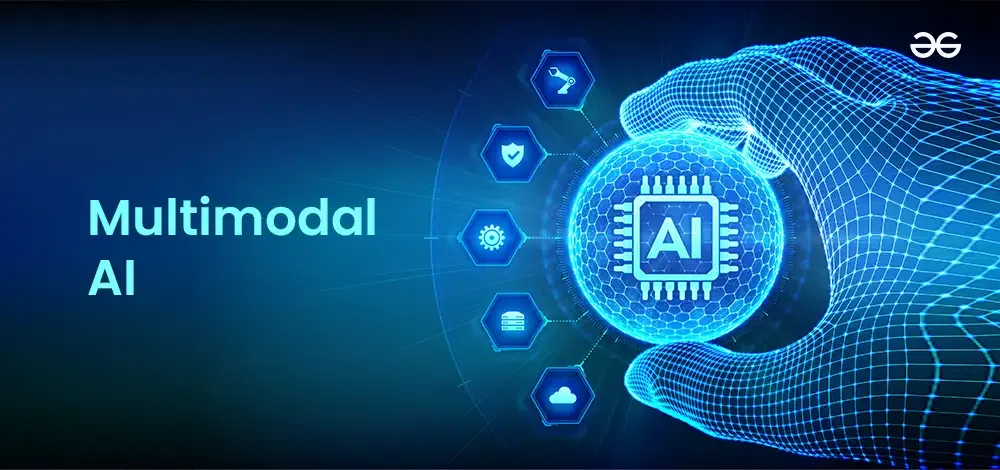Multi-modal AI: Teaching Machines to See, Hear, and Understand
- Get link
- X
- Other Apps
Multimodal AI: Teaching Machines to See, Hear, and Understand

Multimodal AI refers to artificial intelligence that can process and understand multiple types of inputs—such as text, speech, images, audio, and video—at the same time. Rather than being limited to a single data type, these systems fuse different data forms to gain a richer, more holistic understanding of real-world contexts.
What Is Multimodal AI?
Imagine showing an AI system a photo of a cat alongside a caption: “What color is this cat?” A multimodal AI can review both the image and the caption, interpret the scene, and respond accurately. This higher-level coordination makes AI interactions more human-like and intuitive.
How Does It Work?
Multimodal AI systems typically consist of three key components:
- Input Modules: Process different data types—text, images, audio—using specialized neural networks.
- Fusion Module: Merges data from different sources at various processing stages (early, mid, or late fusion).
- Output Module: Generates responses—text, images, or audio—based on the combined understanding.
This synergy allows an AI assistant to handle voice commands while interpreting images, or to generate captions for videos and photos.
Why Is It Important?
- Richer Understanding: Combines sensory inputs for better context.
- Improved Accuracy: Multiple data types reduce ambiguity.
- Enhanced Creativity: Enables text-to-image or text-to-video generation.
- Natural Interactions: Feels more human-like and seamless.
Real-World Applications
1. Healthcare
AI can analyze X-rays, listen to doctors' notes, and read medical histories simultaneously to assist with diagnoses.
2. Autonomous Vehicles
Self-driving cars integrate cameras, lidar, GPS, and audio to navigate safely.
3. Virtual Assistants
Assistants like Siri and Alexa are evolving to process voice, images, and gestures for more dynamic interactions.
4. Content Creation
Tools can turn text prompts into videos or images, revolutionizing creative industries.
5. Retail & Customer Support
AI can analyze browsing history, customer feedback, and product images to offer personalized recommendations.
Top Models Today
- GPT-4V / GPT-4o (OpenAI): Combines text, image, and audio capabilities.
- Google Gemini: Integrates text, image, audio, and video understanding.
- Meta’s ImageBind & Llama 3.2: Focus on vision-language tasks.
- Runway Gen-2: Generates videos from text prompts.
Challenges Ahead
- Computational Cost: Needs powerful hardware to train and run effectively.
- Privacy & Security: Handling sensitive data responsibly is crucial.
- Interpretability: More complex models are harder to explain.
- Data Bias: Ensuring diverse, unbiased training data is key.
The Road Ahead
The future of multimodal AI looks promising, with trends like:
- On-device multimodality: Running on smartphones and laptops for real-time use.
- Agentic AI: AI systems that can plan and act autonomously across tasks.
- Creative explosion: Generating rich media—videos, music, and more—from simple prompts.
- Ethical development: Prioritizing transparency and fairness.
Conclusion
Multimodal AI is changing the way machines interact with us—by seeing, hearing, and understanding our world. As this technology evolves, it’s crucial to balance innovation with ethical practices and transparency. With careful development, multimodal AI will shape the future of healthcare, creativity, education, and beyond—bridging the gap between human and machine understanding.
👉 Related: For a solid foundation, check out our beginner-friendly guide: Getting Started with AI: A Beginner’s Guide to the Future.
Have questions or thoughts? Leave a comment below and let’s discuss how multimodal AI might impact your life!
- Get link
- X
- Other Apps
Comments
Education is evolving quickly, and AI is leading the way. Adaptive learning, smart content, and automated grading are now common. Teachers and administrators benefit greatly from an Artificial Intelligence (AI) Strategy Course to understand how to use these tools meaningfully and responsibly. Technology should empower, not replace, great educators.
ReplyDeleteAbsolutely! AI is transforming education, but as you said, it should empower—not replace—great educators. That course sounds like a smart step for anyone in the field. Thanks for sharing!
Delete